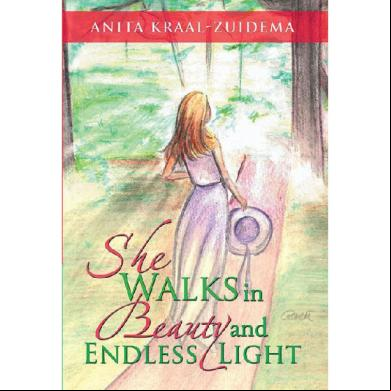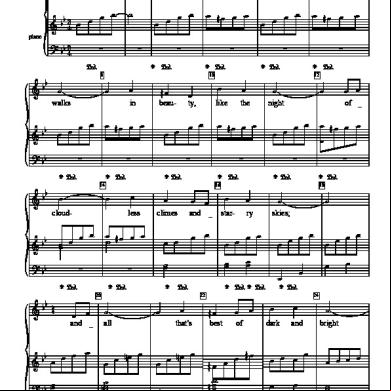Analysis Of She Walks In Beauty By Lord Byron 56642x
This document was ed by and they confirmed that they have the permission to share it. If you are author or own the copyright of this book, please report to us by using this report form. Report 2z6p3t
Overview 5o1f4z
& View Analysis Of She Walks In Beauty By Lord Byron as PDF for free.
More details 6z3438
- Words: 553
- Pages: 1
Analysis of She Walks in Beauty by Lord Byron In Lord Byron’s poem, She Walks in Beauty, the poet praises a woman’s beauty. Yet, the poet not only focuses on the external appearance of the woman but extends his glorification onto the internal aspect of her, making the woman more divine and praiseworthy. The first stanza of the poem describes the physical appearance of the woman. Byron starts the poem with the phrase “She walks in beauty, like the night/ Of cloudless climes and starry skies;.”(1-2) Here, the poet creates an image of a dark, clear sky with twinkling stars, and make a contrast between brightness and darkness. The second stanza of She Walks in Beauty continues to praise the woman’s appearance, but starting from line 11, the poet extends this external beauty onto the woman’s personality. In the phrase “Had half impaired the nameless grace,”(8) the poet tells us that the woman’s face is in such a perfect portion that just a slight change would damage it. By adding the word “nameless” in front of the word “grace,” the poet enlarged the woman’s beauty and greatness, thereby suggesting it as something so priceless that can’t be defined nor expressed as a name. The last stanza also talks both about the woman’s inner and outer characteristics. Her cheek and her smiles are beautiful. In the phrases “days in goodness spent,”(16) “mind at peace,”(17) and “heat whose love is innocent,”(18) we understand that the woman’s inner thoughts are also as pure and graceful just as her appearance. As in previous stanzas, he once again shows the theme of this poem, which is the woman’s physical beauty along with her internal beauty. Now, let’s go on to analyzing the form of She Walks in Beauty. each line composed of an iambic tetrameter. the great use of simple rhymes creates a soft atmosphere, seemingly portraying the nature of the woman. Also, the repetition of the “unstressed-stressed” words gives us a soft, stepping rhythm. Major poetic mechanisms Byron used in this poem. First, the poet uses personification such as “smiles that win”(15) and “heart whose love is innocent,”(18) to vividly describe the woman’s soft smiles and pure heart. use of similes and metaphors in parts “like the night,”(1) “nameless grace / which waves in every raven trees,”(8-9) the poet compares “grace”(8), the quality of the woman, to an observable phenomenon “raven trees”(9) and makes the portray more clear. Lastly, to give the poem a smooth flow, the poet uses alliteration in parts such as “cloudless climes,”(2) “starry skies,”(2) “day denies,”(6) and “serenely sweet.”(11) These intended usages of words contribute also in deepening the meaning of the words. To summarize, the overall tone of She Walks in Beauty is soft and calm, quite different with the image we have about poet, Lord Byron. Perhaps this extreme contrast between the lovely poem and the author who have lived a dissipated lifestyle makes the poem touches us stronger. We could vividly feel how strong Byron’s iration of the woman was. Use of soft and simple languages rather than heavy, intellectual words is also significant, as it demonstrates the pure, easily noticeable beauty of the woman. The woman portrayed in this poem must have been truly beautiful to catch Byron’s attention at once, and make him write such a vivid poem.










